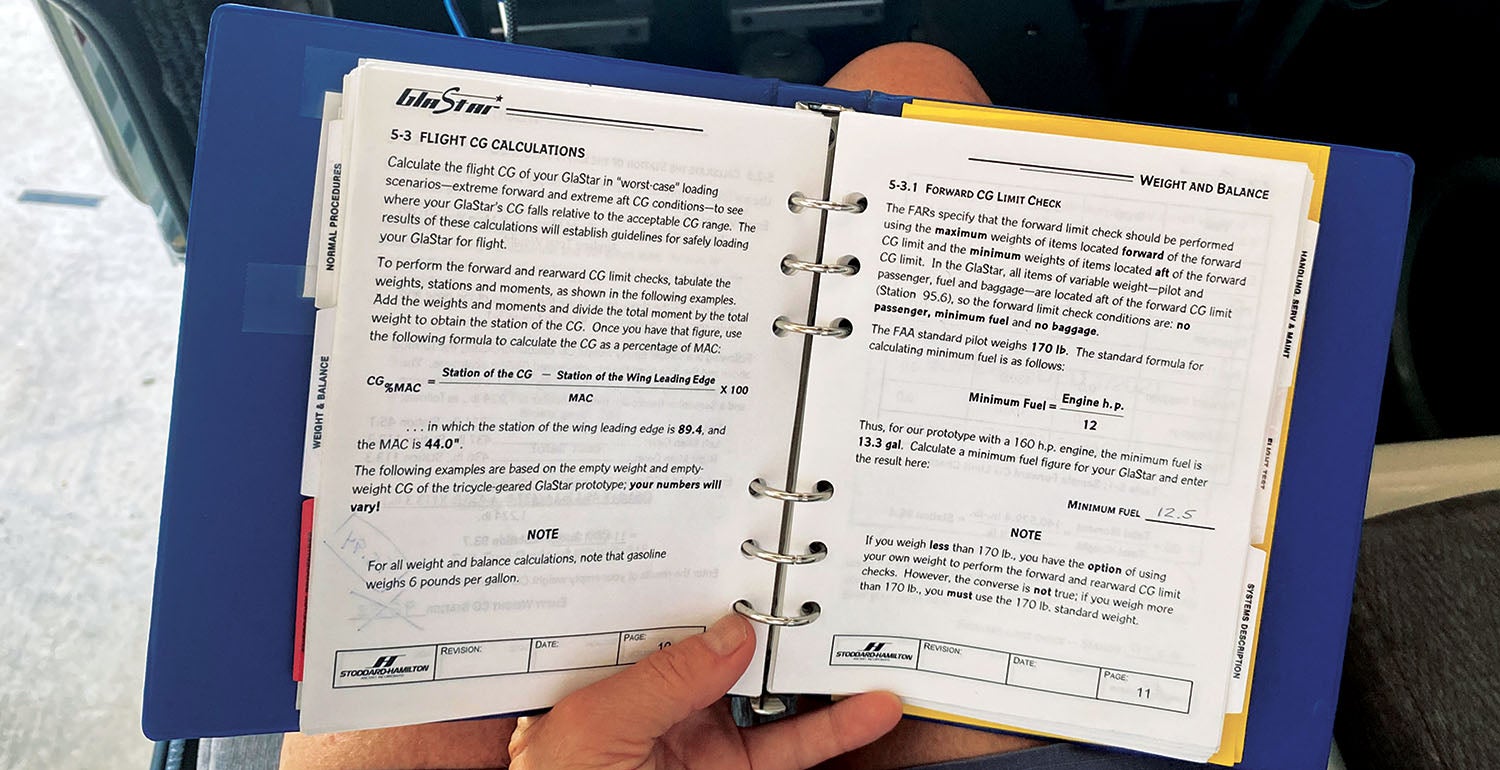 Brett taxied the recently completed aircraft over to the hangar where Ted was waiting. He reviewed the instruments and then shut down.
Brett taxied the recently completed aircraft over to the hangar where Ted was waiting. He reviewed the instruments and then shut down.
“So that’s your third flight. How did it go? All’s well?” asked Ted.
“Great. I used the checklist you helped me put together, and performance was right where it was supposed to be. Having the information organized sure made a difference in the time to put the flight testing together and definitely gave me a comfort level in the air so far.”
Ted nodded. “Yes. I’m glad I finally convinced you. But you’re not done with the paperwork.”
“Right. I need to be filling out my test cards.”
“Not just test cards, Brett. You’re correct, but you’re just at the beginning of assembling a Pilot’s Operating Handbook. The numbers you come up with from your flight testing will go into the handbook.”
“Not just the test cards?”
“The whole idea of pulling everything else together was to speed your build, give you a margin of safety, provide confidence, help you with flight testing, and assemble a POH for this specific aircraft. So the data you are collecting on the test cards give you the numbers to go in your POH.”
It was as if fireworks had gone off next to Brett. His eyes widened as he looked at Ted. “I get it! It all makes sense now!”
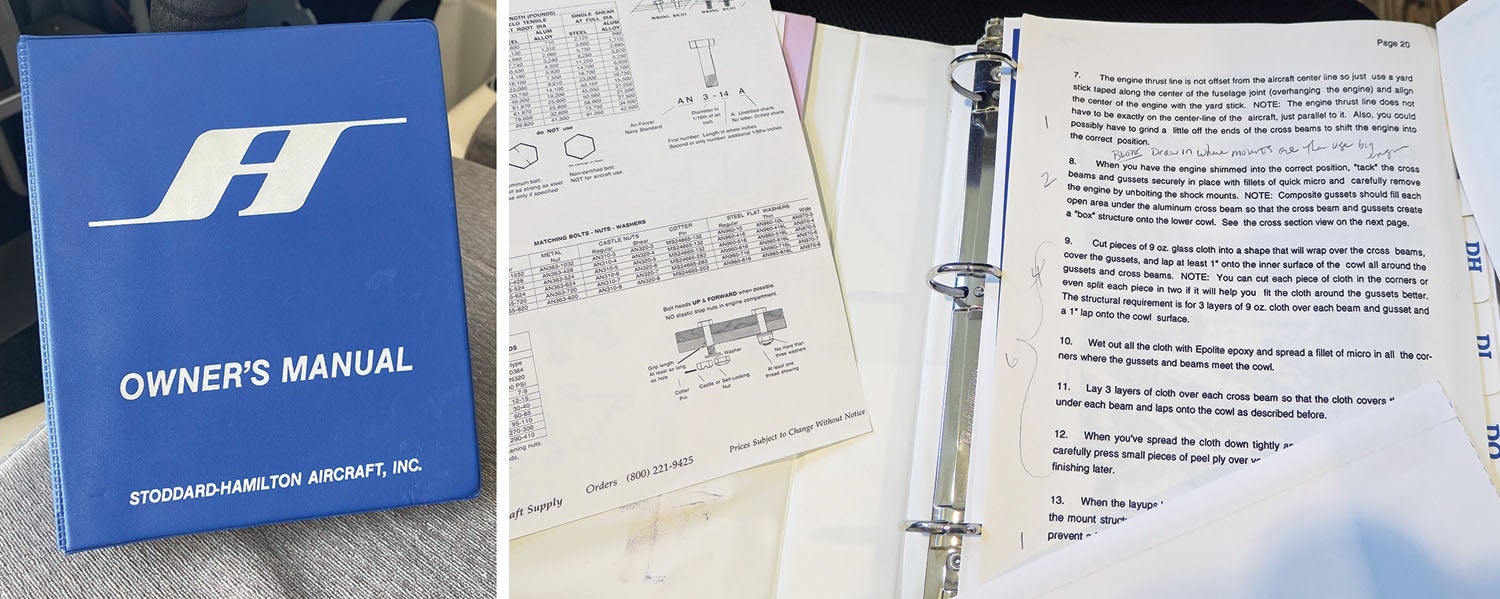
Not Just Extra Work
Pulling all of your documentation together during your build and organizing it is extra work that you may not feel like doing, but you’ll thank yourself later. (See “What Shape Is Your Documentation In?” from the October 2021 issue.) You’ll thank yourself every time you refer to it later when you are flying, doing maintenance or performing a preflight inspection. It gives you quick answers, saves time when you need data for purchases or for repairs, adds a margin of safety to your flying and offers peace of mind for the next owner.
As you use the voluminous information you’ve assembled, you may end up spending extra time looking for specifics that would be handy as standalone items. These pieces of information include aircraft specifications, maintenance data like oil quantity and type, V-speeds, weight and balance calculations and checklists. Since you’re not going to drag the notebooks into the airplane every time you fly, assembling a Pilot’s Operating Handbook is the perfect solution.
Our homebuilt airplanes don’t require a Pilot’s Operating Handbook (POH). That’s one reason why there is so much variability in the documentation we have for our airplanes. We do, however, have a legal requirement to carry our operating limitations on board the aircraft along with our airworthiness certificate and weight and balance calculations. This is as formal as it gets. I would argue that we should, as builders and pilots, assemble a thorough POH even though we don’t have to.
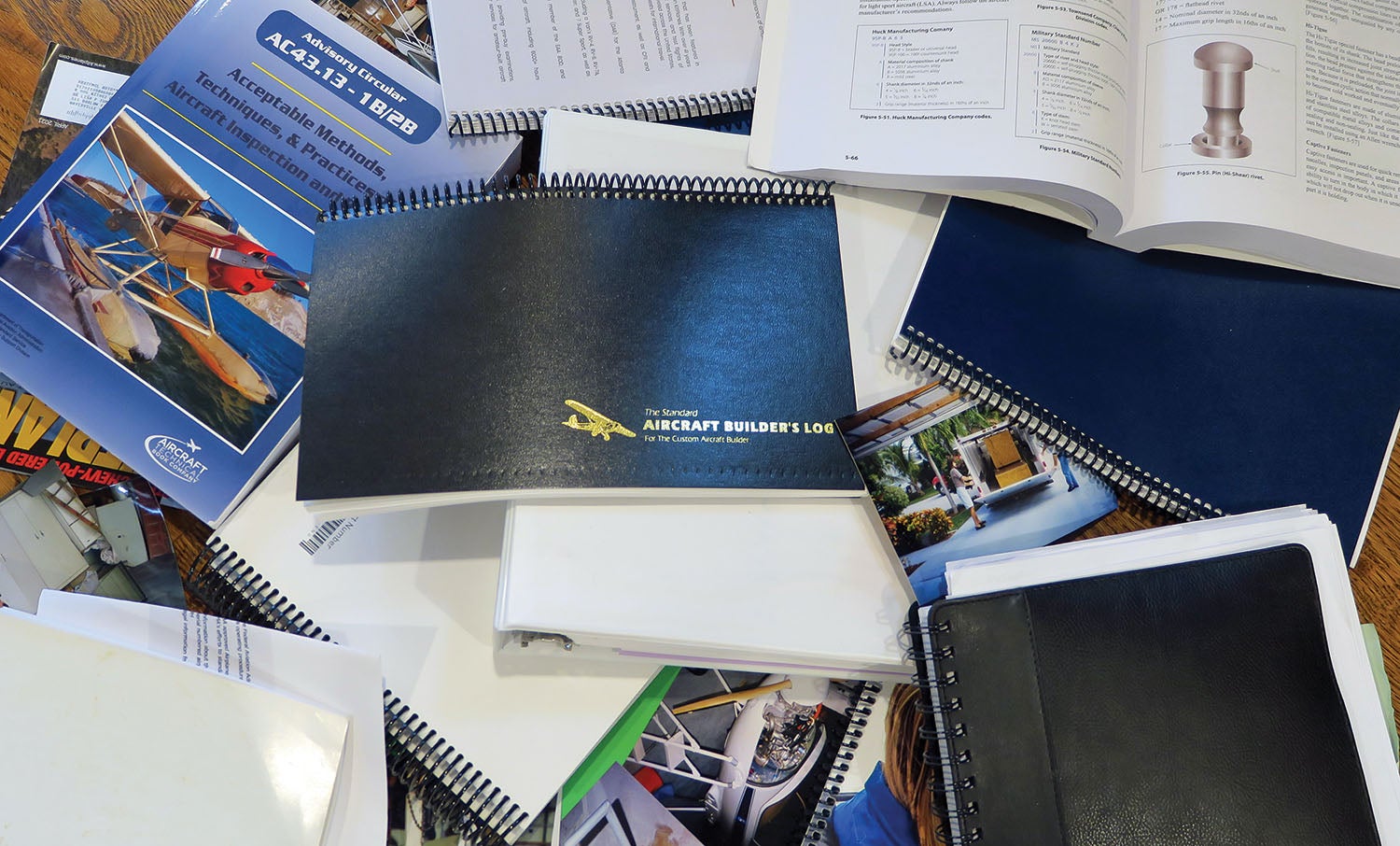
When I first started building in the 1990s, I had few documents. The plans and the assembly instructions, along with manuals for the engine and accessories, were it. Now aircraft manufacturers are doing a much better job providing detailed documentation for our building and operation. But not all manufacturers include a POH in the kit. If you don’t have one, here is how to put one together from the work you’ve already done.
We need not reinvent the wheel. I recommend starting by pulling a good example of a POH off the internet and using that template to make your own. An excellent General Aviation Manufacturers Association (GAMA) style POH example is the now discontinued Cessna 162 Skycatcher. The manual is easily found online. I recommend you download it and use it as a guide.
Once you’ve seen the state of the art, look for some others, such as the Merlin Pilot Operating Handbook. In this short and well-done PDF, you’ll see the basics laid out for a single-place aircraft with a Rotax 582.
Van’s Aircraft sets the standard for homebuilt POHs. Check out their up-to-date, GAMA-style handbooks on the company website (https://tinyurl.com/4a72k4as).
Your POH will be populated with the most pertinent information from all of the binders or notebooks you already assembled during your build. This includes specifications, operating limitations, emergency procedures, V-speeds, preflight information, weight and balance and flight data.
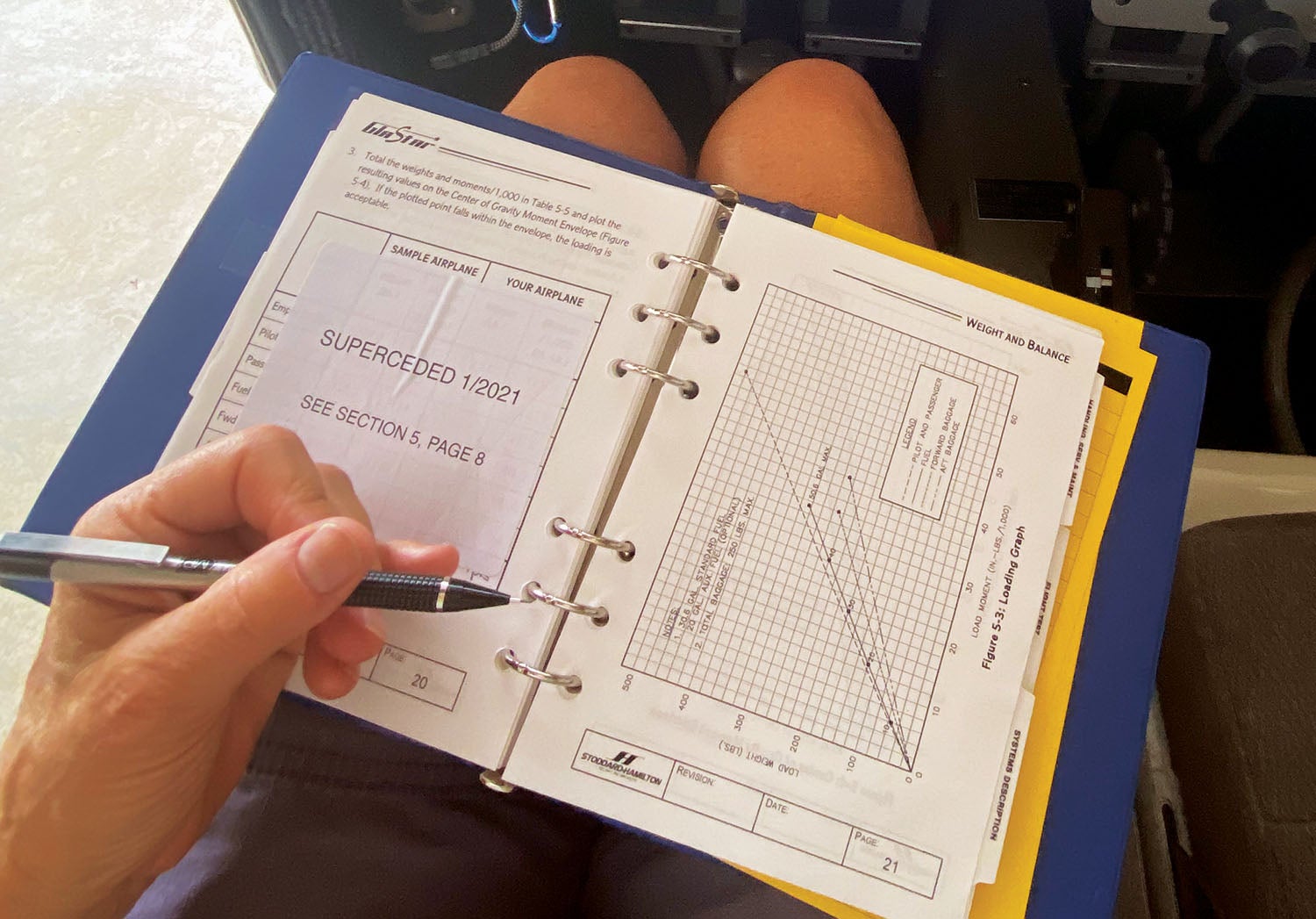
Steps
The physical form for your book can be anything from a notebook to a 5×8-inch printed manual to a kneeboard assembly (see “What’s in Your POH,” by Glen Salmon, April 2015 KITPLANES®). The ability to print a single perfect bound book (get two) as a service from most commercial printers is surprisingly affordable. Put the content together first, and then decide how you will format it.
Here are the standard sections in a typical POH. Edit to suit. Each section will draw from the work you did assembling the data during the building process. Since some of the information is in the form of originals in your notebooks, make copies of these to place in the POH. That way, you can put the binders in a safe place and work from the handbook.
- Front cover with photo, title, serial number and registration number
- Revision Summary Page
- General Information
- Operating Limitations
- Emergency Procedures
- Normal Procedures
- Performance Data and Specs
- Weight and Balance & Equipment List
- Aircraft Systems
- Aircraft Handling, Aircraft Maintenance & Servicing
- Accessories and Avionics
- Notes & blank pages for additions
Boilerplate
With so many POHs already written, there is no reason for you to write your own descriptions of common items, weight and balance theory or formulas, or any emergency procedures. You will need to spend some time reviewing the books already written and make sure that what you copy and paste is a fit with some editing and rewriting on your part. Be respectful of copyright restrictions. While it’s OK to use an existing POH as a guide for your work, it’s not a good idea to copy it verbatim.
Although time-consuming to pick and choose from a variety of manuals, you will end up saving time because you do not have to write everything from scratch. The weight and balance and emergency sections are particularly useful.
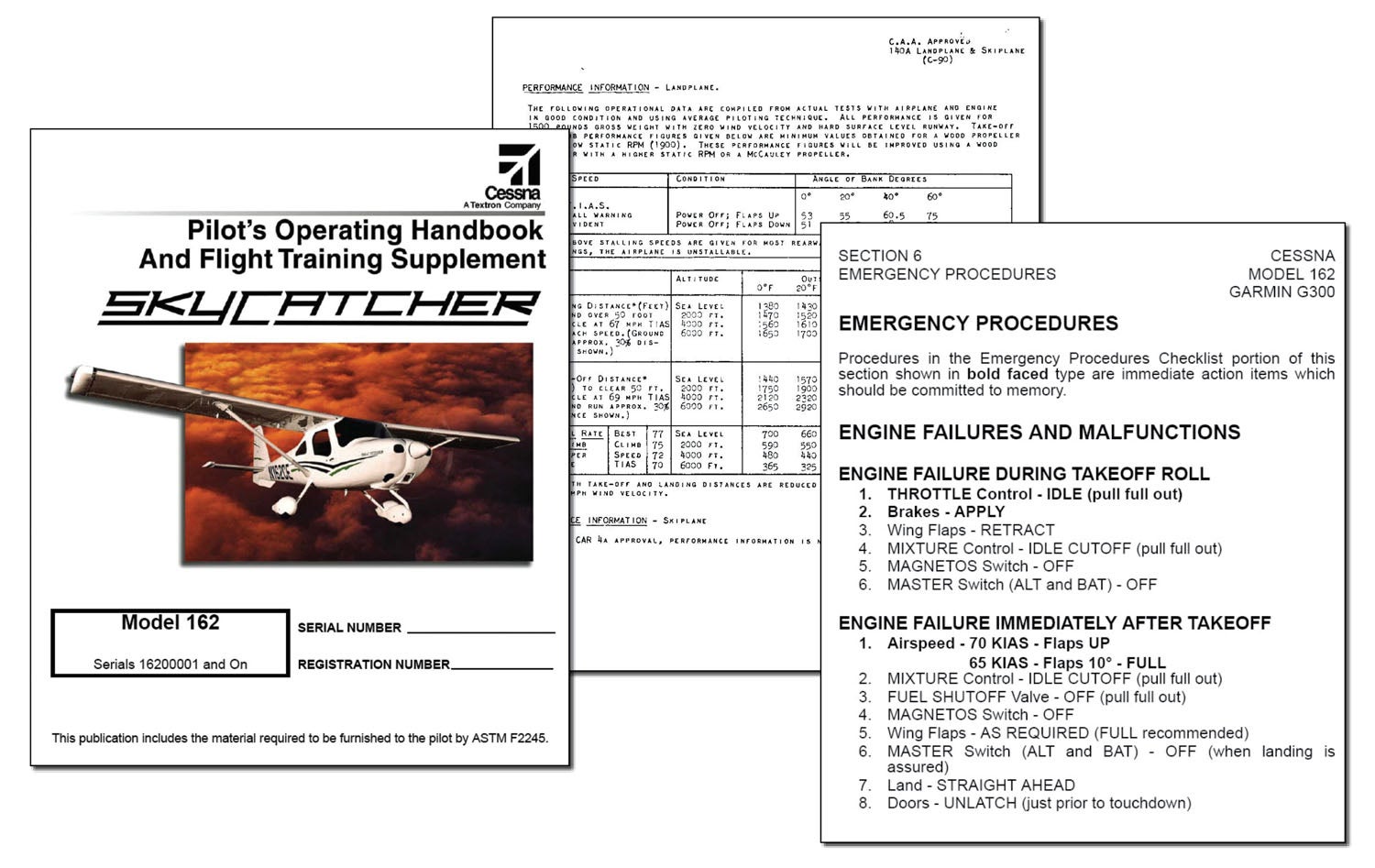
Checklists
Checklists are invaluable. Although you will have checklists already assembled from your previous work during the build, you should take a good look at the sample POHs and see if you missed anything.
Even though you will have extensive checklists in your POH, I’d pull the emergency procedures and the preflight procedures out onto their own sheets of paper and laminate them for day-to-day use.
Technicalities
How do you actually get this information into POH form? You may be adept at building but not at assembling a book. My advice is to populate each section as a document (MS Word, Pages, or whatever you use for word processing) and then pay a virtual assistant on Upwork or Fiverr to assemble it into a POH. Send them the template you like and ask them to format yours just like it. You’ll be surprised at how inexpensive these services are. Once you have both a text (Word) document and PDF, it will be easy to update.
Documentation may be the last thing we think about when we’re building, but it will be the first thing we need in an emergency or when we have to troubleshoot a problem. You will be glad that you spent the time to produce a POH.














Exactly what I needed!
I have found that pulling the checklist info out the Airplane Flight Manual (rather than PoH) onto separate laminated checklists is useful.
Checklists and flows tend to get developed with practice and tweaks to the aircraft. So the checklists tend to get updated quite a lot. The AFM – less so.
It saves some pages (and so weight) in the AFM and I simply have a line in the AFM that states: “See separate checklists carried in the aircraft.”
Same for the W&B which I keep as a separate document. As the aircraft changes with mods and needs reweighing – I just update the W&B document – not the whole AFM.
YMMV
This is an excellent suggestion. I’ll incorporate it in my advice to builders. Thank you.